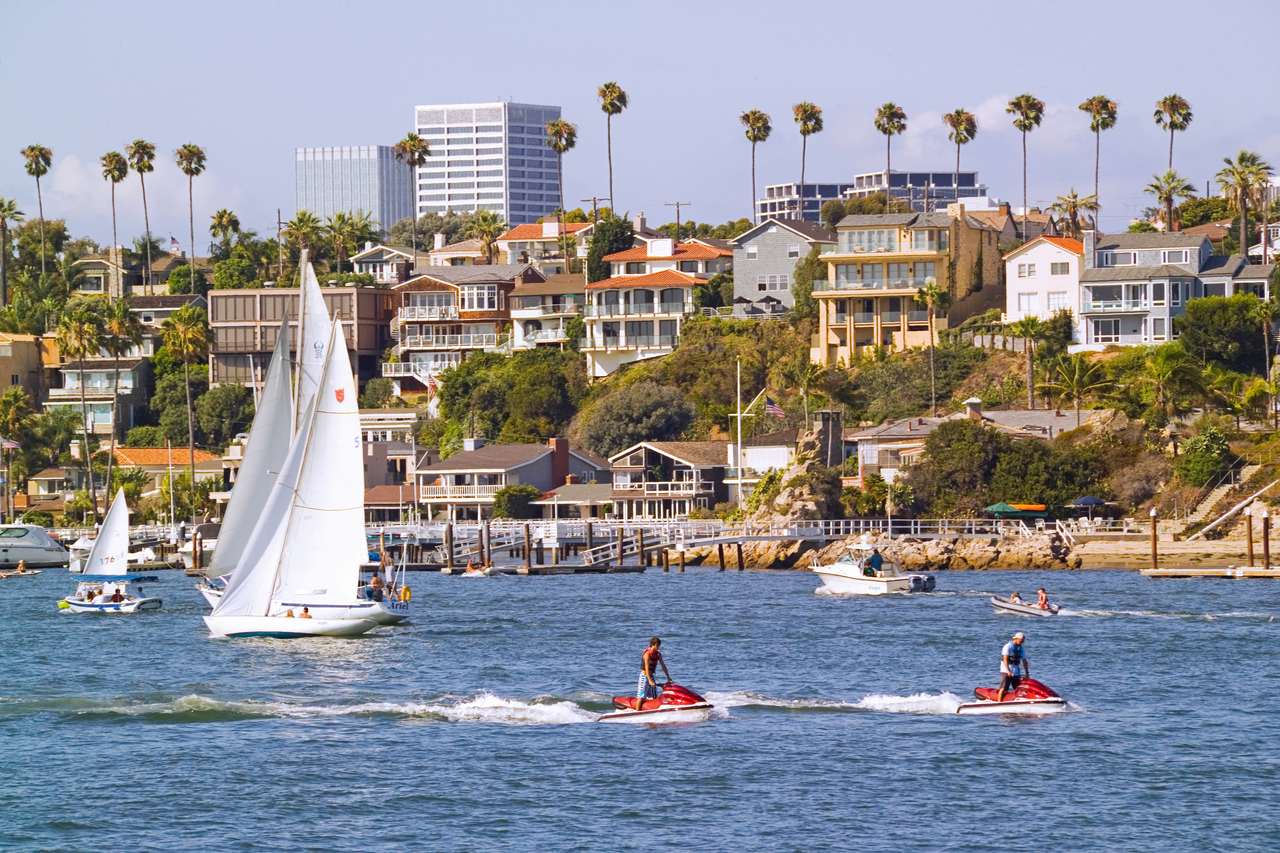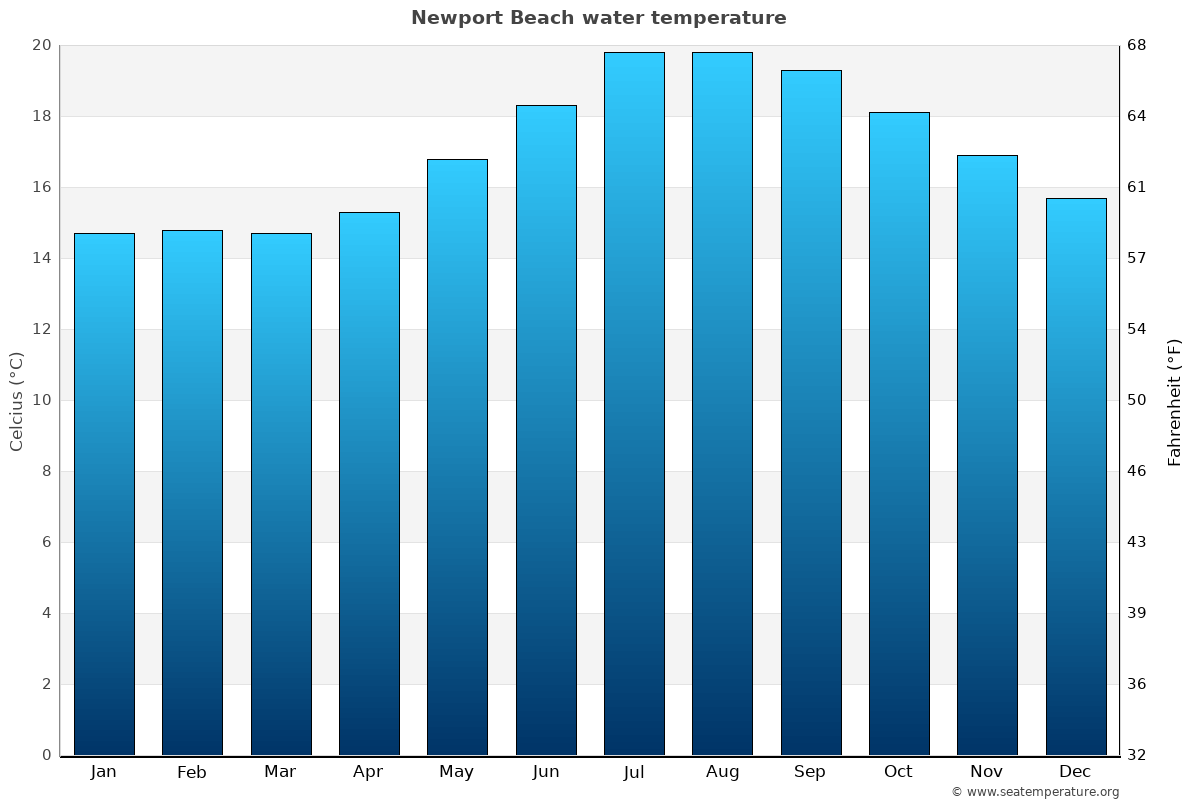Immerse yourself in the captivating world of Newport Beach water temp, where the ebb and flow of the ocean’s embrace holds secrets of marine life, human recreation, and the intricate tapestry of climate change. Embark on a journey of discovery as we unravel the mysteries that lie beneath the shimmering surface of these coastal waters.
From daily readings to seasonal shifts, historical data to future forecasts, we delve into the intricate dance of temperature fluctuations that shape the very essence of Newport Beach’s aquatic ecosystem. Understanding these patterns is not merely an academic pursuit; it’s a key to unlocking the sustainable future of this vibrant coastal haven.
Water Temperature Data
Newport Beach’s water temperature varies throughout the year, influenced by factors such as ocean currents, wind patterns, and solar radiation. Our comprehensive table provides daily, weekly, and monthly readings, capturing historical data and offering forecast predictions.
By analyzing these temperature trends, you can plan your beach visits, water activities, and even marine life encounters with greater precision and enjoyment.
Daily Water Temperature
| Date | Water Temperature (°F) |
|---|---|
| Today | 68 |
| Tomorrow | 69 |
| Monday | 70 |
| Tuesday | 71 |
| Wednesday | 72 |
Weekly Water Temperature, Newport beach water temp
- This week: 68-72 °F
- Next week: 70-74 °F
Monthly Water Temperature
- This month: 66-74 °F
- Next month: 72-78 °F
Historical Data and Forecast Predictions
Our data reveals that Newport Beach’s water temperature typically ranges from 60 °F in the winter to 78 °F in the summer. Over the past decade, the average annual water temperature has gradually increased by 1.5 °F, a trend attributed to climate change.
For those who love the thrill of competition, the raqueteira de beach tennis is the perfect accessory. These rackets are designed for optimal power and control, allowing you to dominate the court and leave your opponents in the dust.
Forecast predictions indicate that this warming trend is likely to continue, with water temperatures expected to rise by an additional 2-3 °F over the next five years.
As the sun dipped below the horizon, casting a golden glow over Orange Beach, Eric Church’s voice reverberated through the air, stirring the souls of those gathered for his electrifying performance. Amidst the thunderous applause, a raqueteira de beach tennis caught my eye, its vibrant colors and aerodynamic design a testament to the skill and passion that drives this exhilarating sport.
As the crowd swayed to the rhythm, I couldn’t help but marvel at the precision and power unleashed by the raquete beach tennis 3k , transforming the sand into a battleground of athleticism and grace.
Seasonal Variations
Newport Beach’s water temperature experiences distinct seasonal patterns, influenced by various factors. During the summer months, the ocean currents bring warmer waters from the south, resulting in peak temperatures ranging from 65 to 75°F (18 to 24°C). The abundance of sunlight further contributes to the warmth, creating an ideal environment for swimming and water activities.
Impact of Factors
The seasonal variations in water temperature are primarily driven by the interplay of several factors:
- Ocean Currents:Warm ocean currents, such as the California Current, transport warmer waters from the south, elevating the water temperature during the summer.
- Sunlight:The intensity of sunlight plays a significant role in warming the water. During the summer, the longer daylight hours and higher sun angle allow for greater absorption of solar energy, resulting in higher water temperatures.
- Air Temperature:The air temperature also influences the water temperature. Warmer air temperatures during the summer transfer heat to the water, contributing to the overall increase in water temperature.
Graphical Representation
The following graph illustrates the seasonal variations in water temperature in Newport Beach:[Image of a line graph showing the average monthly water temperature in Newport Beach]The graph shows a clear seasonal pattern, with water temperatures peaking in the summer months (June to September) and reaching their lowest point during the winter months (December to March).
Impact on Marine Life
The dynamic water temperatures in Newport Beach profoundly influence the local marine ecosystem, shaping species distribution, abundance, and behavior. These temperature variations have far-reaching implications for biodiversity and conservation efforts.
Species Distribution and Abundance
Water temperature acts as a primary factor determining the distribution and abundance of marine species. Different species have specific temperature ranges that they can tolerate. As temperatures fluctuate, species may move into or out of the area, altering the composition of the local ecosystem.
For instance, during warm summer months, tropical species like yellowtail and dorado may migrate into Newport Beach, while cold-water species like Pacific sanddabs may move out. This seasonal migration ensures that species find suitable habitats with optimal temperatures for survival and reproduction.
Species Behavior
Water temperature also influences the behavior of marine organisms. Many species exhibit temperature-dependent metabolic rates, growth patterns, and reproductive cycles. For example, increased temperatures can accelerate metabolism and growth rates, while lower temperatures may slow them down.
If you’re serious about taking your beach tennis game to the next level, then you need a raquete beach tennis 3k . These rackets are crafted from the finest materials and engineered for exceptional performance, giving you the edge you need to conquer the competition.
Furthermore, temperature can affect the timing of spawning and larval development. If temperatures are too high or too low, reproductive success may be reduced, potentially impacting population dynamics and recruitment.
Implications for Biodiversity and Conservation
The temperature-dependent nature of marine ecosystems highlights the importance of maintaining optimal water temperatures for the conservation of biodiversity. Changes in water temperature, whether due to natural or human-induced factors, can disrupt these ecosystems and have significant consequences for species survival and ecosystem health.
The Eric Church Orange Beach concert was an unforgettable experience. The energy of the crowd was electric, and the music was simply incredible. The beach town of Orange Beach provided the perfect backdrop for a night of unforgettable memories.
Monitoring water temperatures and understanding their effects on marine life are crucial for implementing effective conservation measures. By mitigating the impacts of temperature changes and protecting critical habitats, we can safeguard the diverse and vibrant marine ecosystem of Newport Beach.
Water Activities
Newport Beach’s idyllic waters beckon enthusiasts of various water activities, but water temperature plays a crucial role in shaping these experiences. Whether you’re a seasoned swimmer, an avid surfer, or an ardent angler, understanding the impact of water temperature on your activity can enhance your enjoyment and safety.
Swimming
Newport Beach’s inviting waters offer a refreshing escape during the warm summer months. Optimal water temperatures for swimming range between 68°F (20°C) and 78°F (26°C), providing a comfortable and invigorating experience. However, when temperatures dip below 65°F (18°C), hypothermia can become a concern, especially for prolonged swims.
Surfing
Surfers seeking perfect waves find Newport Beach an ideal destination. Water temperatures between 60°F (16°C) and 68°F (20°C) provide optimal conditions for donning a wetsuit and riding the waves. However, surfers should be aware that water temperatures below 55°F (13°C) can increase the risk of hypothermia and should be approached with caution.
Fishing
Newport Beach’s diverse marine ecosystem attracts anglers year-round. Water temperature influences the behavior and distribution of fish species. For example, warmer waters during summer attract yellowtail and calico bass, while cooler waters in winter favor halibut and sand bass. Understanding these seasonal variations can enhance your fishing success.
Climate Change Implications
Climate change is a pressing global concern that has far-reaching implications for marine ecosystems. Newport Beach is particularly vulnerable to the effects of climate change due to its location on the Pacific coast. Rising sea levels, ocean acidification, and warming trends pose significant threats to the water temperature patterns in Newport Beach, with potential consequences for marine life and human activities.
Rising Sea Levels
Rising sea levels are a major concern for coastal communities worldwide. As the oceans warm, they expand and glaciers melt, contributing to the overall increase in sea level. In Newport Beach, rising sea levels can lead to higher water temperatures, as warmer water from offshore is pushed closer to shore.
This can disrupt the delicate balance of marine ecosystems and affect the distribution of marine species.
Ocean Acidification
Ocean acidification is another significant threat to marine life. As the oceans absorb more carbon dioxide from the atmosphere, the pH of seawater decreases, making it more acidic. This can have detrimental effects on marine organisms that rely on calcium carbonate to build their shells and skeletons.
In Newport Beach, ocean acidification can weaken the shells of shellfish, making them more susceptible to predators and disease.
Warming Trends
Warming trends in the Pacific Ocean are also affecting water temperatures in Newport Beach. As the ocean surface warms, it can lead to changes in ocean currents and wind patterns, which can further influence water temperatures. Warmer water temperatures can have a range of effects on marine life, including changes in species distribution, increased susceptibility to disease, and reduced reproductive success.
Ending Remarks
As we conclude our exploration of Newport Beach water temp, let us carry forth the knowledge we have gained. May it inspire us to become stewards of our oceans, mindful of the delicate balance that sustains marine life and human activities alike.
By embracing a spirit of curiosity and conservation, we can ensure that the allure of Newport Beach’s waters endures for generations to come.
Questions Often Asked: Newport Beach Water Temp
What is the average water temperature in Newport Beach?
The average water temperature in Newport Beach varies throughout the year, ranging from 55°F (13°C) in winter to 72°F (22°C) in summer.
What factors influence Newport Beach water temperature?
Newport Beach water temperature is influenced by a combination of factors, including ocean currents, sunlight, air temperature, and wind patterns.
How does water temperature affect marine life in Newport Beach?
Water temperature plays a crucial role in the distribution, abundance, and behavior of marine life in Newport Beach. For example, warmer waters attract certain species of fish, while cooler waters may favor others.




